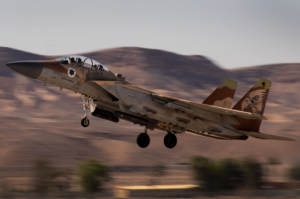
The largest U.S. Air Force aircraft procurement program dollar increase advised by the Senate Appropriations Committee defense panel’s (SAC-D) fiscal 2026 report is $1.7 billion for Lockheed Martin [LMT] C-130Js, including $1.5 billion for eight, unrequested aircraft for Air National Guard units and $200 million unrequested funds for the LC-130J polar transport.
The Northrop Grumman [NOC] B-21 Raider stealth bomber got a $666 million “classified” reduction from SAC-D compared to the Air Force’s nearly $2.6 billion request.
The panel added nearly $619 million for two unrequested EA-37B Compass Call planes by L3Harris Technologies [LHX] and BAE Systems.
The companies have been pitching the Air Force and legislators to double the buy of EA-37Bs from the planned 10, including two more in fiscal 2026 and four more in fiscal 2027 (Defense Daily, Apr. 8).
While the Air Force requested almost $224 million for B-52 modifications in fiscal 2026, SAC-D reduced that by $128 million due to Radar Modernization Program (RMP) development delays.
In May, the Air Force said that RMP had exceeded the 15 percent, significant unit cost increase threshold under the fiscal 1982 NDAA’s Nunn-McCurdy provision “due to design, production, and installation cost increases” (Defense Daily, May 19).
RMP for the 74 B-52Hs is to include a new, active electronically scanned array radar based on RTX‘s [RTX] APG-79; a new, wide-band radome by L3Harris on the aircraft’s nose; two L3Harris 8 x 20 inch high definition displays for the radar navigator and the navigator; two new, hand controllers by California-based Mason Controls; and new display sensor system processors by L3Harris to interface between the radar and other B-52 systems.
SAC-D also cut the Air Force’s nearly $607 million research and development request for the future nuclear-tipped Long Range Standoff Missile (LRSO) by $235 million due to unjustified funds requested by the Air Force for termination liability–sunk costs that a company invests in facilities and equipment that the contractor cannot reuse if the government cancels a contract.
The Air Force has targeted a Milestone C production decision for RTX‘s [RTX] LRSO in fiscal 2027 and has said that it wants LRSO to be operational in the early 2030s.
The B-52H bomber is to get a new rotary launcher for LRSO, and eventually the Air Force wants LRSO to fly aboard the B-21.
On Air Force munitions, SAC-D gave a $1 billion plus up to the Air Force’s $328 million request for the Lockheed Martin [LMT] Joint Air-to-Surface Standoff Missile (JASSM)–$800 million for more missiles and $200 million for a second source builder of cruise missile motors.
The RTX Advanced Medium Range Air-to-Air Missile (AMRAAM) received $807 million from SAC-D, a $442 million production plus up from the Air Force request. Yet, SAC-D also said that it wants the Air Force to follow through on its AMRAAM multi-year procurement (MYP) plan.
“The committee is particularly concerned by the inability of the Department of the Air Force and certain defense contractors to proceed with a MYP contract for the Advanced Medium-Range Air-to-Air Missile, as approved by Congress in fiscal year 2024,” according to the report on the SAC-D bill. “The committee notes that this avoidable failure has resulted in lost opportunities to stabilize the supply chain and further delays production. The committee reiterates its expectation that these procurements should result in unit cost savings, stability in the supplier base, industry investment in expanding and upgrading their facilities, and weapons being delivered at cost and on or ahead of schedule. Accordingly, the committee directs the secretary of defense to provide a semi-annual report to the congressional defense committees on the status of each such munition MYP award until all munitions covered under such award have been delivered, to include projected and realized cost savings, the amount and impact of government and industry investment on capacity and associated supply chains, and an assessment of the extent to which such award has generated greater stability in the associated supply chain.”
Like their House counterparts, Senate defense appropriators declined to begin winding down the rapid prototyping program for the Boeing [BA] E-7 Wedgetail, as requested by DoD. The E-7 program has been an effort to replace the Air Force’s E-3 AWACS fleet. SAC-D provides $847 million for the E-7 in fiscal 2026–a $647 million plus up from the DoD request.
“The committee notes that at the inception of the U.S. E–7 program, the purchase of this existing Australian capability was heralded as the Department of Defense making use of rapid acquisition
authorities, and that this proposed termination, after over $2 billion in investment in less than four fiscal years, raises questions about the Department of the Air Force’s ability to successfully
execute rapid prototyping programs intended to result in the fielding of major capabilities,” according to the SAC-D report. “Nevertheless, the committee is concerned that the Department of the Air Force request proposes too much reliance on space-based capabilities for air-moving target indicators, which are themselves early in development. Moreover, termination of the E–7 in favor of space-based capabilities creates a gap in battle management and command and control capabilities and reduces the resilience of Air Force early warning and control efforts.”
For U.S. Space Force, SAC-D reversed the requested zeroing of the Space Development Agency’s (SDA) Tranche 3 Transport Layer (T3TL) effort in fiscal 2026 and added $500 million for it.
The Department of the Air Force is conducting an Analysis of Alternatives on future satellite communications (Defense Daily, June 26).
The SDA Transport Layer “is a critical component of the [SDA] Proliferated Warfighter Space Architecture [PWSA] and was designed and purpose-built as a tactical communication layer with the resiliency to withstand adversary attacks and reliably deliver mission critical data directly to service members,” according to the SAC-D report. “The capability and capacity of the Transport Layer must keep pace with the missile warning/missile tracking layer. A pause to the T3TL development will lead to a disconnect between the Tracking and Transport layers of the PWSA. Therefore, the committee directs the secretary of the Air Force to continue the T3TL development program as approved in the Full-Year Continuing Appropriations and Extensions Act, 2025 (Public Law 119–4) and recommends an additional $500 million for said purpose. In addition, the committee directs the secretary of the Air Force to resource the T3TL program across the fiscal year 2027 Future Years Defense Program at an annual amount not less than the program cost estimate.”
SAC-D also added $55 million for the tactical, surveillance, reconnaissance, and tracking (TacSRT) pilot program that uses commercial data analytics for combatant commanders. The Department of the Air Force did not budget for TacSRT in fiscal 2024 and fiscal 2025, but Congress funded the program at $40 million in both fiscal 2024 and 2025.
The Space Force’s fiscal 2026 “fails to request adequate resources to continue the [TacSRT] effort,” SAC-D said in its report. “The TacSRT program, while only in its pilot phase, has instituted a novel commercial marketplace for commercial remote sensing tasking, vendor competition, and execution of the requirement in tactically relevant timelines. The committee commends the United States Space Force’s ability to rapidly institute a new acquisition process for commercial solutions that satisfy dynamic combatant commander needs. In the current atmosphere of acquisition reform, this program is a testament to the ability of a dedicated workforce to put mission first and identify a path through existing policies for rapid results. Therefore, the committee recommends an additional $55 million for continued execution of the TacSRT program through combatant command directed requirements. In addition, the committee directs the secretary of Air Force to establish the TacSRT combatant command directed tasking program as an enduring program across the Future Years Defense Program within the commercial services budget line item.”
The House Armed Services Committee’s (HASC) fiscal 2026 defense bill would require the Chairman of the Joint Chiefs of Staff to establish a Title 10 requirement for TacSRT and would mandate that the Department of the Air Force fund TacSRT as a “program of record” (Defense Daily, July 15).














